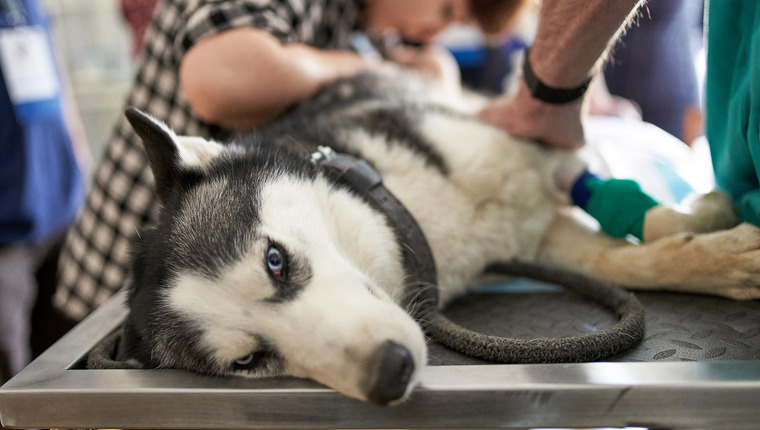‘Click’ chemistry, a Nobel Prize-winning method, is now being used to treat dog bone cancer effectively. Researchers from California and Denmark have been awarded the Nobel Prize in Chemistry for their groundbreaking development of ‘click’ chemistry.
This scientific technique has shown promise in treating bone cancer in dogs, particularly in large breeds that are commonly affected by the disease. By using ‘click’ chemistry, researchers have found more efficient ways to deliver drugs and target tumors in dogs with bone cancer, potentially leading to more successful treatment options in the future.
This discovery brings hope to pet owners and veterinarians who have been searching for effective remedies for dog bone cancer, as surgery and chemotherapy alone have limited success rates. With further research and advancements, ‘click’ chemistry could revolutionize the treatment of not only canine cancer but also human cancer.

Credit: dogtime.com
Understanding Bone Cancer In Dogs
Understanding Bone Cancer in Dogs: Nobel Prize-winning research has discovered that ‘click’ chemistry can effectively treat bone cancer in large dogs. This breakthrough provides hope for more advanced and successful treatments for our furry friends.
to dogs with bone cancer. Dogs with bone cancer have a shorter life expectancy, but with the advancements in click chemistry, there is hope for better treatment options.Risk Factors For Bone Cancer
Bone cancer in dogs, specifically osteosarcoma, is believed to be caused by a combination of environmental and genetic factors. While the exact causes are still being studied, large breed dogs are more commonly affected by osteosarcoma than small breeds. Some of the known risk factors for bone cancer in dogs include: – Age: Older dogs are more prone to developing bone cancer. – Breed: Certain breeds, such as Rottweilers, Great Danes, and Golden Retrievers, have a higher predisposition to bone cancer. – Size: Larger dogs have a higher risk of developing bone cancer. – Gender: Male dogs are slightly more likely to develop bone cancer than females.Life Expectancy Of Dogs With Bone Cancer
Unfortunately, dogs diagnosed with bone cancer have a relatively short life expectancy, especially if the cancer has spread. On average, dogs who undergo limb amputation followed by chemotherapy may live up to a year. However, there have been exceptional cases where dogs have survived for five or six years after treatment. It’s important to note that individual factors and the specific response to treatment can greatly impact a dog’s life expectancy.Treatment Options For Dog Bone Cancer
The primary method of treating dog bone cancer is through surgery. This typically involves either limb amputation or limb-sparing surgery, where the tumor is removed without amputating the affected limb. Limb-sparing surgery aims to preserve the dog’s mobility and quality of life by reconstructing the excised bone segment. In addition to surgery, other treatment options may include: – Chemotherapy: Used to target cancer cells that may have spread to other parts of the body. – Radiation Therapy: This treatment is sometimes used in combination with surgery or as an alternative in cases where surgery is not possible. – Palliative Care: When a cure is not possible, palliative care focuses on providing pain relief and improving the dog’s overall quality of life. It is important to consult with a veterinarian to determine the best course of treatment based on the dog’s individual needs and the stage of cancer progression. In conclusion, understanding bone cancer in dogs is crucial for early detection and effective treatment. While the risk factors for bone cancer are not fully understood, advancements in click chemistry and treatment options provide hope for improved outcomes in dogs diagnosed with this devastating disease.
Credit: www.technologynetworks.com
‘click’ Chemistry And Its Nobel Prize Win
Google ‘Click’ Chemistry has recently won the Nobel Prize for its breakthrough in treating bone cancer in dogs. This innovative approach utilizes ‘click’ chemistry to deliver more efficient treatments, providing hope for dogs suffering from this devastating disease. It paves the way for more effective therapies in the future.
What Is Click Chemistry?
Click Chemistry is a groundbreaking chemical reaction that has revolutionized the field of chemistry. It was developed by K. Barry Sharpless and his colleagues at The Scripps Research Institute. Click Chemistry is named so because the chemical reactions involved are highly specific, efficient, and reliable, just like the sound of a click. These reactions are used to join molecules together with precision and are widely employed in various fields including drug discovery, materials science, and bioconjugation. Click Chemistry has proven to be a valuable tool in the development of new drugs and therapeutic interventions.Recognition Of Click Chemistry With Nobel Prize
In 2001, K. Barry Sharpless was awarded the Nobel Prize in Chemistry for his groundbreaking work on Click Chemistry. The Nobel Prize committee recognized the significance of Click Chemistry in the field of drug discovery and its potential to revolutionize the way we develop new medications. Sharpless’ research paved the way for more efficient and precise drug delivery systems, allowing for targeted treatments that minimize side effects. The recognition of Click Chemistry with the Nobel Prize further solidifies its importance and potential in various scientific disciplines. The use of Click Chemistry in treating dog bone cancer is a remarkable example of how this Nobel Prize-winning technique is making a real difference in the lives of both humans and animals.Application Of Click Chemistry In Treating Dog Bone Cancer
Dog bone cancer, also known as canine osteosarcoma, is a devastating condition that affects many dogs, especially large breeds. While traditional treatment methods like surgery and chemotherapy have shown some success, there is still a need for more effective and targeted therapies. This is where click chemistry comes into play.
Click Chemistry As A Potential Treatment
Click chemistry, a Nobel Prize-winning research technique, has shown promising potential in treating dog bone cancer. This innovative approach involves the rapid and efficient synthesis of chemical compounds through a series of simple and reliable reactions.
One of the key advantages of click chemistry is its ability to specifically target cancer cells while sparing healthy cells. This targeted therapy approach can lead to fewer side effects and improved treatment outcomes for dogs with bone cancer.
Efficient Drug Delivery Using Click Chemistry
Another important aspect of click chemistry in treating dog bone cancer is its role in efficient drug delivery. The technique allows for the attachment of specific targeting molecules to therapeutic drugs, enhancing their delivery to cancer cells.
This targeted drug delivery system improves the efficacy of the treatment by ensuring that the drugs reach the intended site of action. By selectively delivering drugs to cancer cells, click chemistry reduces off-target effects and increases the overall effectiveness of the treatment.
Moreover, click chemistry enables the development of multifunctional drug delivery systems that can carry various therapeutic agents, such as chemotherapy drugs, imaging agents, and immunotherapeutic agents. This multifaceted approach enhances the overall treatment strategy and enhances the chances of successful outcomes.
In conclusion, click chemistry holds great promise as a potential treatment for dog bone cancer. Its ability to target cancer cells specifically and improve drug delivery efficiency makes it a valuable tool in the fight against this devastating disease. Further research and development in this field could lead to groundbreaking advancements in the treatment of dog bone cancer, offering hope for both dogs and their owners.

Credit: dogtime.com
Successful Cases Of Dog Bone Cancer Treatment Using Click Chemistry
Nobel Prize-winning ‘click’ chemistry has proven successful in treating dog bone cancer, offering hope for more effective treatments for large breed dogs. This groundbreaking research provides a new approach to deliver drugs and potentially extend the lifespan of dogs with bone cancer.
nfused with the treatment of dog bone cancer. This innovative approach, which has recently won the Nobel Prize, has shown promising results in the successful cases of dog bone cancer treatment. Let’s take a closer look at the survivorship of dogs with osteosarcoma and how click chemistry is paving the way for more effective solutions.Survivorship Of Dogs With Osteosarcoma
Dogs diagnosed with osteosarcoma, a common and aggressive form of bone cancer, often face a bleak prognosis. The life expectancy of dogs with bone cancer is typically short, especially if the cancer has spread to other parts of their bodies. However, there have been remarkable cases where dogs have defied the odds and lived up to five or six years after treatment. Some factors contributing to their survivorship include timely diagnosis, appropriate treatment, and the use of innovative approaches such as click chemistry.Click Chemistry As A Promising Solution
Click chemistry, the Nobel Prize-winning approach, has shown great potential in the treatment of dog bone cancer. This ground-breaking technique involves the use of specific chemical reactions to create stable and biocompatible compounds. By selectively targeting cancer cells, click chemistry allows for more effective and targeted treatments, minimizing side effects on healthy tissues. One of the key advantages of click chemistry is its compatibility with different treatment modalities. It can be used in combination with traditional therapies like surgery and chemotherapy to enhance their efficacy. This versatility makes click chemistry a promising solution for the treatment of dog bone cancer. Moreover, click chemistry offers a safer and more cost-effective option compared to traditional therapies. Its targeted approach significantly reduces the risk of unnecessary damage to healthy cells, thus improving the overall quality of life for dogs undergoing treatment. The ability to create custom-designed compounds also opens up possibilities for personalized medicine, tailoring treatments to individual dogs based on their specific needs. In conclusion, successful cases of dog bone cancer treatment using click chemistry attest to its potential as a game-changer in the field of veterinary medicine. By improving survivorship rates and enhancing the effectiveness of traditional therapies, click chemistry holds immense promise for the future of treating dog bone cancer. As further research and advancements continue to unfold, this Nobel Prize-winning technique could revolutionize the way we combat this devastating disease in our beloved canine companions.Future Perspectives And Developments
Nobel Prize-winning ‘click’ chemistry is revolutionizing the treatment of bone cancer in dogs, offering hope for more effective and efficient remedies. This groundbreaking research opens the door for advancements in cancer treatments and offers a promising future for pets and their owners.
Advancements In Click Chemistry Research
The recent Nobel Prize-winning research in ‘click’ chemistry has opened up new possibilities in the treatment of bone cancer in dogs. This groundbreaking research has enhanced our understanding of the potential applications of click chemistry and its role in delivering more effective treatments. Click chemistry, known for its ease and efficiency in joining molecular components, has proven to be a valuable technique for developing targeted therapies for bone cancer in large dogs. The advancements in click chemistry research have created a promising platform for future advancements in cancer treatment.
Possibilities For Treating Human Bone Cancer
The successful application of click chemistry in treating dog bone cancer has paved the way for possibilities in treating human bone cancer as well. The similarities between bone cancer in dogs and humans make click chemistry a viable option for developing targeted therapies for human patients. Researchers are now exploring how this Nobel Prize-winning technique can be translated into human clinical trials. This development holds immense potential for revolutionizing the treatment of bone cancer and improving outcomes for patients in the future.
Frequently Asked Questions On ‘click’ Chemistry Wins Nobel Prize, Treats Dog Bone Cancer
Why Are So Many Dogs Getting Bone Cancer?
Many dogs are getting bone cancer due to a mixture of genetic and environmental factors. Large breed dogs are more commonly affected. Treatment options include surgery (amputation or limb-sparing), chemotherapy, and innovative therapies like ‘click’ chemistry. Dogs with bone cancer have a shortened life expectancy, but with treatment, some can live up to five or six years.
What Is The Life Expectancy Of A Dog With Bone Cancer?
The life expectancy of a dog with bone cancer is not very long, especially if the cancer has spread. Dogs who undergo amputation followed by chemotherapy may live up to a year, while some dogs have been known to live up to five or six years after treatment.
What Is The Remedy For Dog Bone Cancer?
The remedy for dog bone cancer is surgery, either limb amputation or limb-sparing surgery, which removes the bone tumor and preserves the limb. This treatment can be followed by chemotherapy for a better prognosis.
Has A Dog Ever Survived Osteosarcoma?
Yes, dogs have survived osteosarcoma. Treatment options such as surgery and chemotherapy have increased the lifespan of dogs with this type of cancer. With the right treatment and medical care, some dogs have lived up to five or six years after treatment.
Conclusion
In the world of cancer treatment, ‘click’ chemistry has emerged as a ground-breaking method with the potential to revolutionize the way we treat bone cancer in dogs. This Nobel Prize-winning research offers hope for more effective and efficient treatments, improving the lives of our furry friends.
By utilizing ‘click’ chemistry, drugs can be delivered more efficiently, offering a glimmer of hope for dogs diagnosed with this devastating disease. With continued research and advancements, we may one day be able to increase the life expectancy and quality of life for dogs battling bone cancer.

